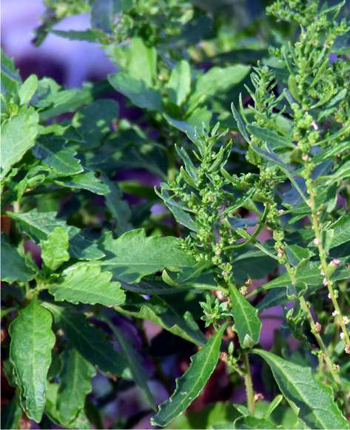Contents:
Common Names | Parts Usually Used | Plant(s) & Culture | Where Found | Medicinal Properties
Uses | Warning | Bibliography
Scientific Names

- Chenopodium ambrosioides L.
- Chenopodium anthelminticum L.
- Goosefoot family
Common Names
- Chenopodium
- Feather geranium
- Goosefoot
- Jerusalem oak
- Jesuit tea
- Mexican tea
Parts Usually Used
Seeds, essential oil
Back to Top
Description of Plant(s) and Culture
Wormseed is a stout aromatic plant 3-5 feet tall. Its erect stem is strongly branched from the base. Oblong or lanceolate with lacerate-pinnatifid margins, its alternate, yellowish-green leaves are marked beneath with small resinous particles. Blooming from July to September, the numerous green flowers grow on almost leafless spikes and are followed by small, green bladdery fruits with solitary, lenticular seeds. Seeds glandular-spotted.
Back to Top
Where Found
Found in waste places in almost all parts of the United States. Naturalized from Central America.
Back to Top
Medicinal Properties
Anthelmintic (killing intestinal worms).
Back to Top
Uses
The oil of chenopodium, derived from the seeds and other overground parts of wormseed, is an excellent anthelmintic for roundworms, hookworms, dwarf tapeworms, intestinal amoeba, and other intestinal parasites, though it is not as effective against large tapeworms. Either the oil or an infusion of seeds with milk was used in treating worms in children. Now largely replaced by synthetics, wormseed is seldom used.
Wormseed is also used as a mild cardiac stimulant and to promote secretions of skin and kidneys.
Back to Top
Warning
This herb’s oil is highly toxic. A dash of the leaves is added as a culinary herb to Mexican bean dishes in the belief that it may reduce gas. May cause dermatitis, vertigo (dizziness or light-headedness) or an allergic reaction.
An overdose of the oil can result in poisoning and death. (a 1 year old baby given a dose of 4 drops 3 times per day for 2 days, died and other cases of overdose deaths are on record.
Do not use wormseed without medical supervision.
Back to Top
Bibliography
![]() The Herb Book
The Herb Book, by John Lust, Bantam Books, 666 Fifth Avenue, New York, NY. copyright 1974.
![]() Eastern/Central Medicinal Plants
Eastern/Central Medicinal Plants, by Steven Foster and James A. Duke., Houghton Mifflin Company, 215 Park Avenue South, New York, NY 10000
![]() American Folk Medicine
American Folk Medicine, by Clarence Meyer, Meyerbooks, publisher, PO Box 427, Glenwood, Illinois 60425, 1973
![]() The Yoga of Herbs: An Ayurvedic Guide to Herbal Medicine
The Yoga of Herbs: An Ayurvedic Guide to Herbal Medicine, by Dr. David Frawley & Dr. Vasant Lad, Lotus Press, Twin Lakes, Wisconsin, Second edition, 1988.
![]() Webster’s New World Dictionary
Webster’s New World Dictionary, Third College Edition, Victoria Neufeldt, Editor in Chief, New World Dictionaries: A Division of Simon & Schuster, Inc., 15 Columbus Circle, New York, NY 10023
